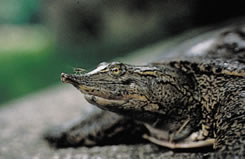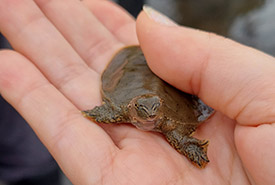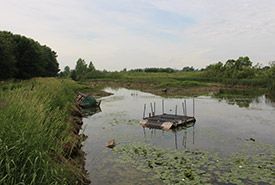Lake Champlain — Spiny softshell turtle habitat conservation

Spiny softshell turtle (Photo by NCC)
The spiny softshell turtle, one of eight freshwater turtle species found in Quebec, owes its name to its leathery shell and its soft spines near its head. Most turtles are recognizable by their hard shell. This one is covered with keratin, the same material that forms human nails and hair. Yes, you read that right; turtles have the equivalent of a big fingernail on their back! Soft-shelled turtles, on the other hand, have no keratin. That's why the bones that form the carapace are instead covered with a kind of very thick skin similar to leather and somewhat soft to the touch. The spines are small and difficult to see. They are located on the front edge of the carapace.
In the past, this reptile could be seen in the Ottawa, St. Lawrence and Richelieu rivers. Today, in Quebec, the spiny softshell turtle is only found at Lake Champlain. Much effort has been put into raising awareness among residents and boaters regarding this very special turtle.
This species, designated as threatened in Quebec and Canada, is weakened because of nautical activities, modified shorelines and water pollution.
Spiny softshell recovery at Lac Champlain
In Quebec’s Lake Champlain, the Nature Conservancy of Canada (NCC) is part of a multi-partner team that has been using radio telemetry to understand the habitat needs of spiny softshell turtles since 1998. By documenting the movements and dynamics of the population of this threatened species, the researchers identified the nesting grounds of female turtles only four kilometres away from the species’ winter hibernating grounds.
Following the discovery, NCC worked with partners and donors to conserve the site. Two properties whose banks have remained in their natural state have been acquired in the Pike River sector. While these two properties have a combined area of just under two hectares, they are of vital importance to several species, including the spiny softshell turtle. Remote monitoring carried out by the Zoo de Granby has demonstrated that the area is used by the hatchlings.

Baby spiny softshell turtle, QC (Photo by NCC)
Now, a team of Conservation Volunteers visits the nesting area each spring to clear it of any litter and prepare it for the arrival of the female turtles in early June. NCC and partners have continued tracking the turtles on an intermittent basis, monitoring the impact of human activities on their well-being. Each year, the zoo's conservation team goes to collect eggs from the one known egg-laying site in Quebec, which is located in the Rivière aux Brochets, and hatches them at the zoo, where they are sheltered from spring floods that could otherwise drown them. Finally, once hatched, the baby turtles are released back into their natural habitat. NCC and partners also started the Mikinak Festival in Pike River. Every summer, the festival invites nature lovers to learn more about this local iconic species and to better understand the region's biodiversity.
Watch this video to hear experts discuss the acquisition of the properties, while Zoo de Granby partners teach us more and release young turtles back into the wild. Enjoy!
Predation, changing shorelines and certain recreational activities (such as motorized boating) all threaten this species' survival. More and more, the banks of lakes and rivers where these gentle reptiles live are being cleared. Without vegetation to control spring flooding, the banks get flooded and turtle eggs are drowned. With no vegetation to filter the water flowing into the lake, water quality worsens, while runoff from farmland brings too many nutrients to water bodies, making it difficult for turtles to breathe below the surface. And since spiny softshell turtles tend to return to the same nesting and hibernation sites year after year, it is even more crucial for researchers to study their habitat needs and conserve these places.
A customized pond

Unique restoration project at Lac Champlain (Photo by NCC)
Thanks to the exceptional collaboration between NCC and the Ministère des Forêts, de la Faune et de Parcs (MFFP), a protected agricultural land in Saint-Georges-de-Clarenceville has benefited from the expertise of several teams of professionals and increased in ecological value.
Reynolds Pond, a shallow pond connected to Lake Champlain by East Swamp Creek, plays an important role in the spiny softshell turtle life cycle. The pond warms up quickly after the snow melts. Adult turtles rush in as soon as spring arrives to feed and warm themselves. However, the pond needed to be redesigned so that turtles (but also fishes) can take maximum advantage of its benefits for a longer period of time.
Successive basins of pits and canals have been created. Mounds, logs and flat stones have also been set up so that the turtles can bask in the sun.
Acknowledgements
NCC would like to extend its warmest thanks to all our partners, donors and volunteers. Your support of our mission is vital to our success and the health of our environment.






Thanks to our financial partners for the Reynolds Pond restoration project
![]()



![]()
Project design and realization
![]()



Thanks also to the following partners


![]()




and the Reynolds family.
Further action
Everyone can play a role in protecting turtles. By greening the shores of Lake Champlain and the banks of streams that flow into it, we can improve both the turtle habitat and water quality. Not only will it provide a healthier environment for the spiny softshell turtle, but also for local communities.
Have you seen a turtle? By letting a local conservation organization know, you can contribute to its protection. Visit carapace.ca.




